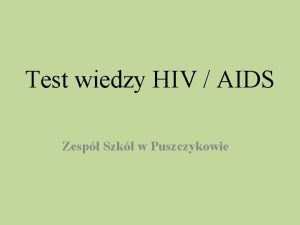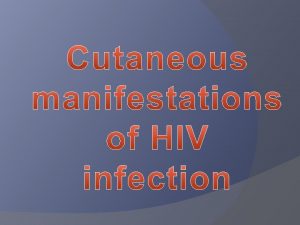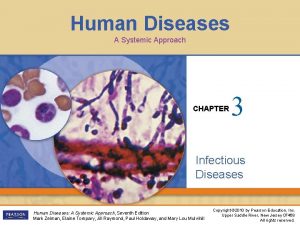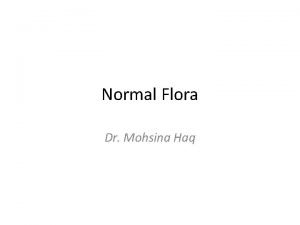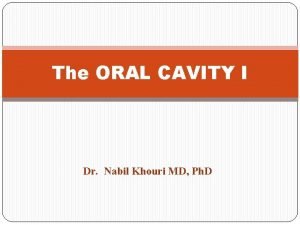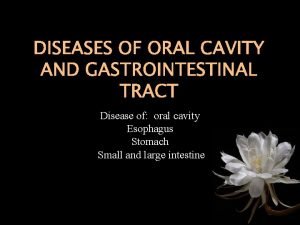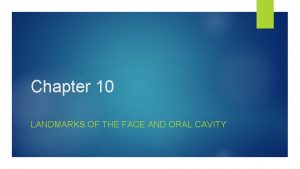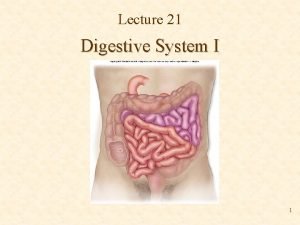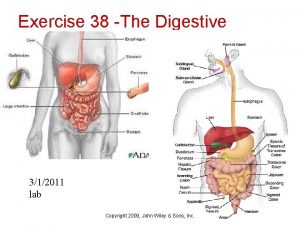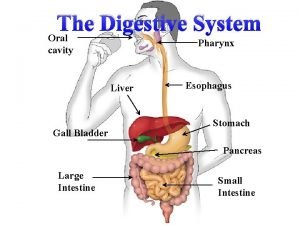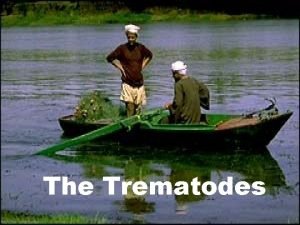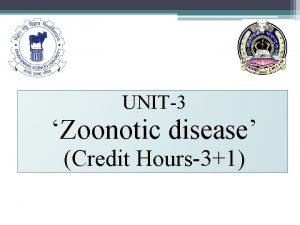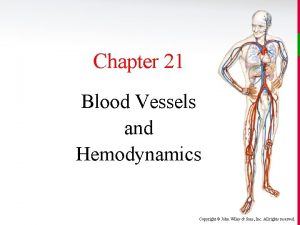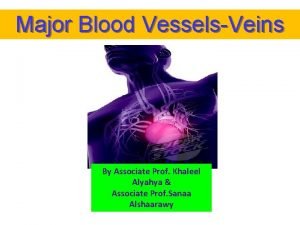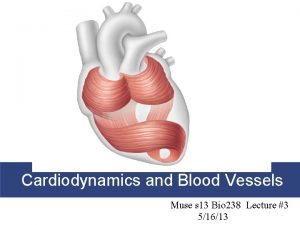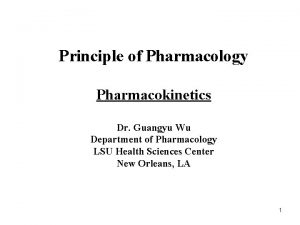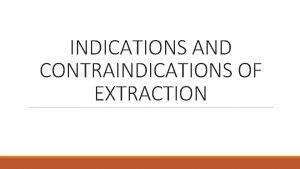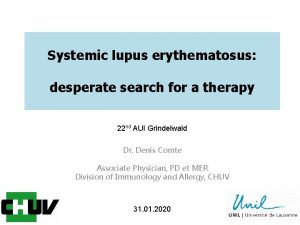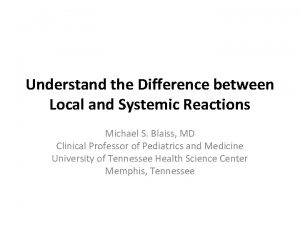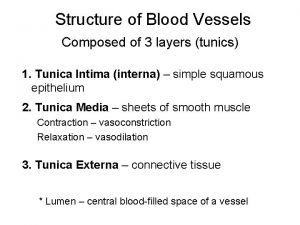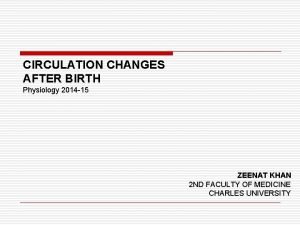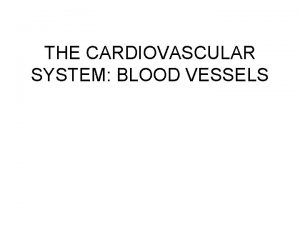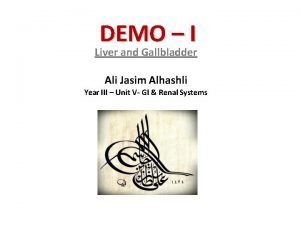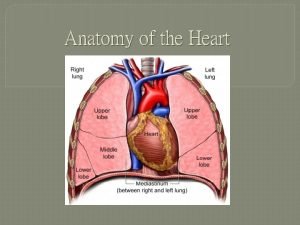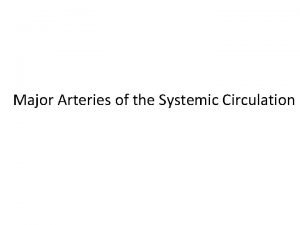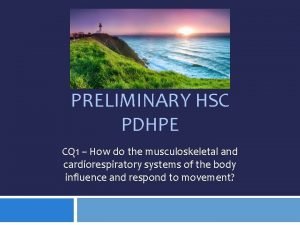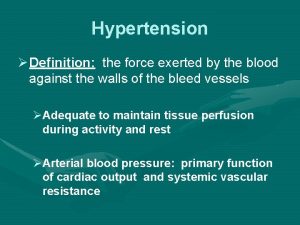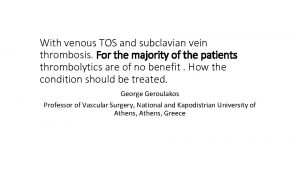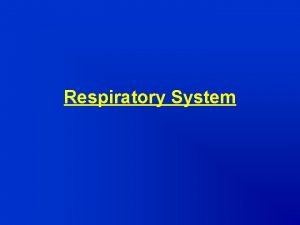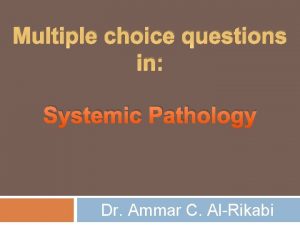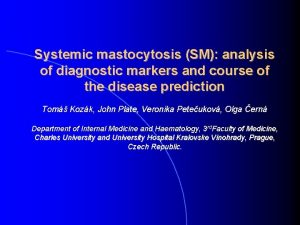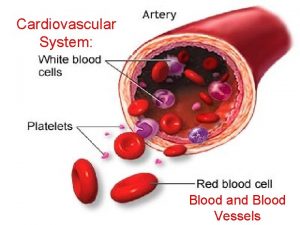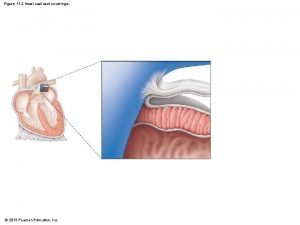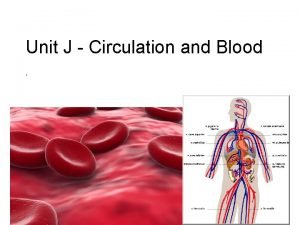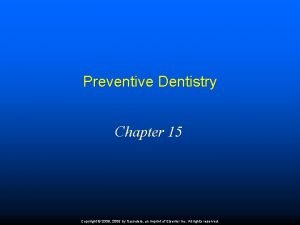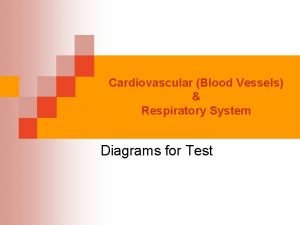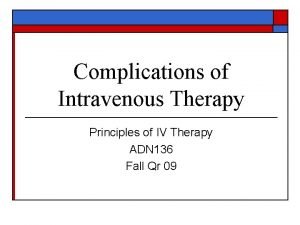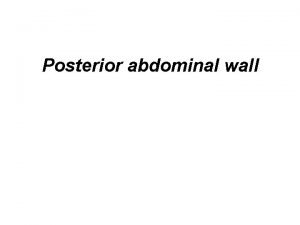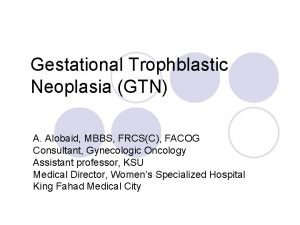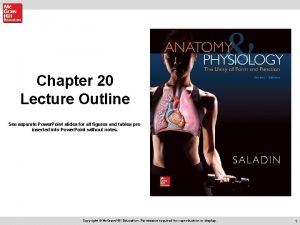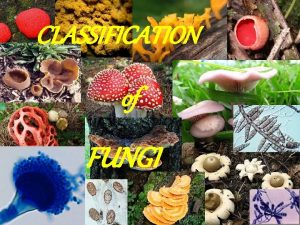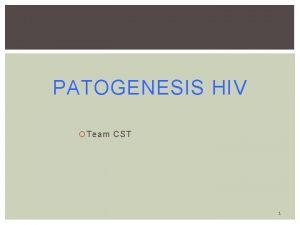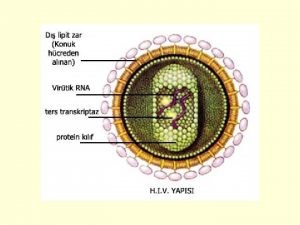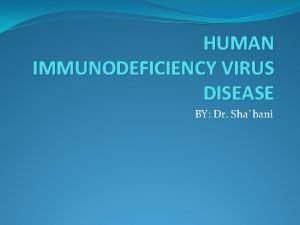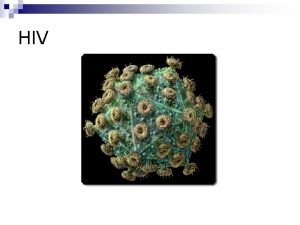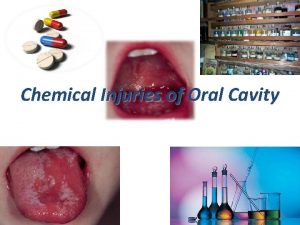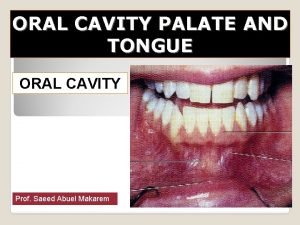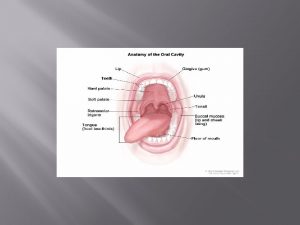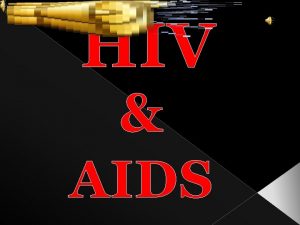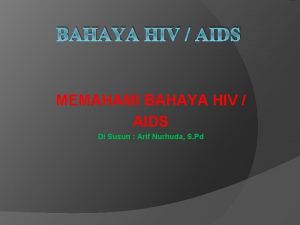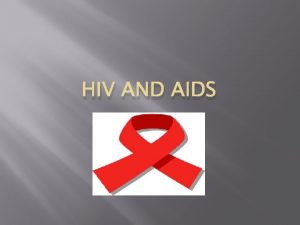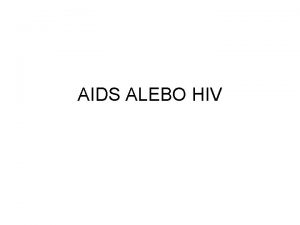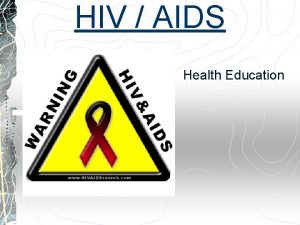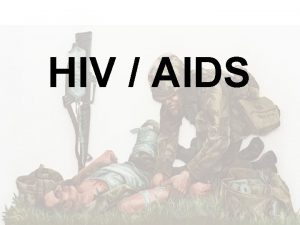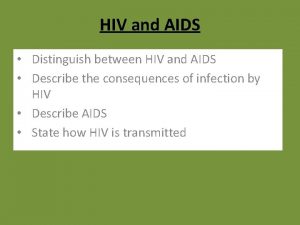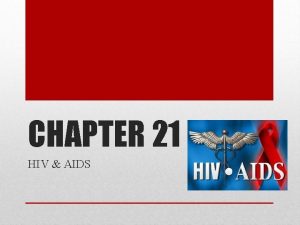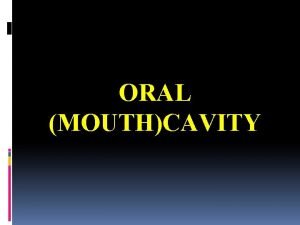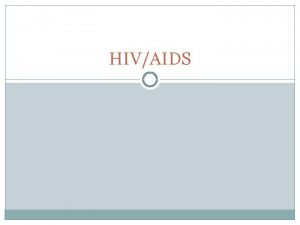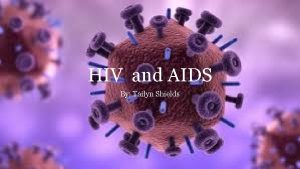DISEASES OF ORAL CAVITY SYSTEMIC DISEASES HIV AIDS





























































































- Slides: 93

DISEASES OF ORAL CAVITY

SYSTEMIC DISEASES - HIV (AIDS) Leukaemia Crohn’s disease Diabetes mellitus Down syndrome Sarcoidosis - Chediak Higashi syndrome -

Normal defense Mechanisms of oral mucosa : 1. 2. 3. 4. 5. Competitive suppression ; by organisms of low virulence Secretory Ig A Other immunoglobulins ; sub mucosal collection of lymphocytes and plasma cells. Antibacterial effect of saliva Irrigation/Cleansing effect of food and drinks

Herpes simplex viral infection - Type : HSV -1, HSV -2 (genital herpes) Age : Children 2 -4 years of age Presentation: - Usually asymptomatic - Gingivostomatitis ; abrupt onset of vesicles/ ulcers - Fever, anorexia, lymphadenopathy

Gross : Vesicles ; few mm – large bullae Filled with clear fluid Ruptures to form shallow ulcer Histology : Intracellular and intercellular edema Intranuclear inclusions Multinucleated giant cells -


Course of the disease : Spontaneous resolution in 3 -4 weeks time. Remain dormant in the ganglion ; trigeminal Reactivation: - Trauma Allergies Exposure of UV light URTI Pregnancy - Menstruation Extremes of temperature -

COMMON SITES OF RECURRENT LESION : n Lips n Nasal Orifices n Buccal mucosa n Gingiva n Hard palate

Disorders of the Lips n Actinic cheilitis Premalignant condition due to chronic UVR exposure n Affects lower lip, initially edematous & erythematous, later atrophic, white, scaly plaque, may obliterate vermillion border n Ulceration or induration biopsy to rule out malignant transformation n

Disorders of the Lips… n Angular cheilitis (perleche) Inflammatory reactionerythema and maceration at the angles of mouth, fissuring and crusting may be present n Predisposing factorsadvanced age, ill-fitting dentures, thumb-sucking in children, oral Candidiasis, bacterial infections n

Disorders of the Lips… n Cheilitis glandularis Inflammatory painless enlargement of lower lip, usually in elderly men n Triggered by actinic damage, bacterial infection, tobacco exposure, chronic irritation n n Cheilitis glandularis apostematosa n Painful enlargement, eversion of lip with erosions and recurrent bacterial infections or malignant transformation

Disorders of the Lips… n Exfoliative cheilitis (factitious cheilitis) Chronic superficial inflammation of vermilion borders of the lips n Characterized by persistent scaling n Attributed to repeated lip sucking, chewing or other manipulation of lips n

Granulomatous cheilitis (cheilitis granulomatosa) n Granulomatous inflammation, acute onset of asymmetric swelling of the upper lip or lower lip n Erythema, scaling, fissuring and erosions may develop n Prolonged and recurrent course with eventual fixed swelling n May be associated with constitutional symptoms, regional lymph node enlargement

Granulomatous cheilitis n Melkersson-rosenthal syndrome- triad of lingua plicata ( fissured or furrowed tongue), facial paralysis and granulomatous cheilitis n Other cranial nerves (olfactory, auditory, glossopharyngeal, hypoglossal) may be involved n Biopsy- oedema, perivascular lymphocytic infiltrate, focal granulomas resembling sarcoidosis or Crohn’s disease

Disorders of Tongue n Glossodynia (burning mouth syndrome)- spontaneous burning, discomfort, pain, irritation, or rawness of the tongue, has no identifiable etiology most of the time n Etiology- Idiopathic, Infection, Allergic/contact hypersensitivity, Mechanical trauma n Xerostomia, Geographic tongue/ Fissured tongue n Vesiculobullous disease, temporomandibular dysfunction n Referred pain from teeth or tonsils n Drugs- Antibiotics, psychiatric medications, chemotherapy n

Etiology of Glossodynia n Neurologic Peripheral nerve damage n Diabetic neuropathy n Trigeminal neuralgia n Acoustic neuroma n n Psychiatric Depression n Anxiety n Cancerophobia n Somatoform disorder n n Systemic disorders Anemia (iron deficiency, pernicious) n Nutritional deficiency n Gastroesophageal reflux disease n Sjogren syndrome n Hypothyroidism n Acquired immunodeficiency syndrome n

GLOSSITIS: Definition: Inflammation of the tongue Causes: - Vitamin B 12 deficiency (Pernicious anemia) - Deficiency of riboflavin, niacin, pyridoxine - Sprue-----Vitamin B deficiency - Iron deficiency anaemia -----Vitamin B deficiency - Plummer Vinson syndrome; Combination of iron deficiency anemia, Glossitis and Esophageal dysphagia

OTHER CAUSES: - Carious tooth Ill - fitting dentures Syphilis Inhalation burns Ingestion of corrosive chemicals

Disorders of Tongue… n Glossitis- presents as pain, irritation or burning, hypogeusia, or dysgeusia n Atrophic glossitis Due to filiform de-papillation n Mild patchy erythema to a completely smooth, atrophic, beefy-red surface n Etiology - pernicious anemia, protein and other nutritional deficiencies, chemical irritants, drug reactions, amyloidosis, sarcoidosis, vesiculobullous diseases, oral candidiasis and systemic infections n Moeller or Hunter glossitis of pernicious anemia affects the lateral aspects and tip of the tongue respectively n

- Presentation : Large beefy tongue Mechanism: Atrophy of papillae ----- Thinning of mucosa ---- Exposure of underlying blood vessels.

Disorders of Tongue… n Median rhomboid glossitis - atrophic disorder of the tongue secondary to chronic candidiasis

Disorders of Tongue… n Geographic tongue- benign inflammatory condition, due to Loss of filiform papillae n Erythematous plaques with an annular or serpiginous well demarcated white border n Etiology- Psoriasis, Reiter syndrome, atopic dermatitis, diabetes mellitus, anemia, hormonal disturbances, Down syndrome, lithium therapy

Disorders of Tongue… n Fissured tongue (furrowed tongue, scrotal tongue, grooved tongue) n normal variant seen in 5 -11% individuals n Numerous small irregular fissures oriented laterally on the dorsal tongue n Also seen in - Melkersson. Rosenthal syndrome, Psoriasis, Down syndrome, Acromegaly, Sjogren syndrome

Disorders of Tongue… n Herpetic geometric glossitis - rare cause of fissuring of tongue, presents with acute onset of pain and deep longitudinal grooves with smaller lateral fissures

Disorders of Tongue… n Hairy tongue (white or black hairy tongue) - hypertrophy of filiform papillae resembling hairlike projections n Associated with - heavy tobacco use, mouth breathing, antibiotic therapy, poor oral hygiene, general debilitation, radiation therapy, chronic use of bismuth containing antacids, lack of dietary roughage n White, yellow green, brown, or black color is due to chromogenic bacteria or staining from exog source

Disorders of Tongue… n Oral hairy leukoplakia- caused by Epstein-Barr virus, presents as asymptomatic, corrugated, white plaques with accentuation of vertical folds along the lateral borders n. Predominantly seen in HIV infection, organ transplant recipients and patients on chemotherapy

Disorders of Tongue… n Macroglossia- congenital or acquired process, tongue is disproportionately large relative to the patient’s jaw size n Difficulty with mastication and speech and accidental tongue biting are common n Differential- Down syndrome, hypothyroidism, Beckwith. Wiedemann syndrome, neurofibromatosis, infection by mycobacteria, filamentous bacteria or fungus, amyloidosis

Disorders of Salivary Glands n Xerostomia (dry mouth) - decreased saliva production n Women are twice as affected as men n Signs and symptoms - diminished or altered taste and smell, halitosis, heavy plaque accumulation, difficulty in wearing dentures, recurrent yeast infections, burning sensation, difficulty swallowing, dry or cracked lips, salivary calculi and increased thirst

Causes of xerostomia n Medications - Antidepressants, antihistamines, diuretics n Medical conditions - Parkinson disease, diabetes, n n n anemia, cystic fibrosis, rheumatoid arthritis Granulomatous inflammation - tuberculosis, sarcoid, Sjögren syndrome, HIV, amyloid Dehydration - Fever, excessive sweating, vomiting, diarrhea, blood loss, burns, smoking, consumption of tea, coffee Radiation therapy of head and neck Surgical removal of the salivary glands Old Age

Disorders of Salivary Glands n Mucocele (mucous retention cysts)- benign, painless, domeshaped fluctuant papules, due to trauma or obstruction of minor salivary gland ducts n Multiple mucoceles - graft vs host disease, lichen planus, cicatricial pemphigoid

Disorders of Salivary Glands n Ranula - large, bluish, translucent fluctuant mass in the floor of the mouth due to obstruction of the submandibular and or sublingual duct n Diffuse parotid gland enlargement - acute mononucleosis, HIV infection

Disorders of Gingiva & Periodontium n Gingivitis - erythema, edema, and blunting of the interdental papillae, without bone loss n Predisposing factors - poor oral hygiene, tobacco use, diabetes n Periodontitis -chronic infection of connective tissue, periodontal ligament and alveolar bone Long-term periodontitis is associated with increased risk of diabetes, heart disease, stroke and preterm birth n birth control pills, diabetes, steroids, Down syndrome, Langerhans cell histiocytosis, HIV predispose to periodontitis n Juvenile periodontitis is associated with genetic defects in leukocyte chemotaxis n n Papillon-Lefevre syndrome - severe and destructive periodontal disease, teeth exfoliation

Disorders of Gingiva & Periodontium n Erosive gingivostomatitis (desquamative gingivitis)- inflammation and erythema of the gingiva, nonspecific reaction pattern, may be due to viral infection, autoimmune, inflammatory and blistering disorders n Lichen planus - painful or asymptomatic lacy white patches, plaques or papules, often with erosions and ulcerations n Lichenoid mucositis - NSAIDS, antihypertensive medications, contact allergy, graft-versus-host disease


GINGIVITIS - - Gingiva: Soft tissue mucosal lining in between the teeth comprising of stratified squamous epithelium. Its inflammation is called gingivitis. Pathogenesis : lack of oral hygiene----dental plaque beneath the gumline----mineralisation---calculus (Tartar)----Release of acidic end product----Inflammation.

Prevalence : Higher in Adolescence Treatment : Aimed at prevention of the disease and reducing the accumulation of plaque/ calculus formation : 1. Brushing 2. Flossing 3. Regular dental visits 4. Maintenance of good oral hygiene

PERIODONTITIS : Inflammation of the supporting structures of the teeth (Periodontal ligament, alveolar bone) - Severe persistent infection----loss of tooth. -

PATHOGENESIS n n n Poor oral hygiene Shift in bacterial flora; 300 different org Facultative gram positive organism – Healthy site Anaerobic gram negative microaerophilic organisms – Diseased site. Actinobacillus, Porphyromonas gingivalis, Provotella intermedia

Disorders of Gingiva & Periodontium n Acute necrotizing ulcerative gingivitis (trench mouth, vincent disease) n Punched- out ulcers of the interdental papillae, gingival hemorrhage, severe pain, foul odor n Fever and lymphadenopathy are common

Disorders of Gingiva & Periodontium n Precipitating factors- poor oral hygiene, nutritional deficiency, alcohol and tobacco use, Immunosuppression n Etiologic agents- Treponema, Selenomonas, Bacteroides, Prevotella and Borrelia vincentii

Aphthous ulceration n Acute, recurrent, painful ulcers on nonkeratinized n n mucosa Most common cause of oral ulcerations Effect up to 40 -50 % of the population Ulcers with a gray or yellow pseudomembrane and erythematous margin Potential triggers - heredity, food and medication allergy, decreased mucosal barrier integrity, hematologic and immunologic disorders, emotional stress, and trauma

Aphthous Ulcers…. . - Superficial ulceration of oral mucosa Age : First two decades Presentation: Extremely painful recurrent lesion Gross: single or multiple , shallow ulcer surrounded by hyperaemia

HISTOLOGY: - Predominant monuclear cells, scattered neutrophils CLINICAL COURSE : - Spontaneous resolution (7 -10 days) Persists for weeks ETIOLOGY : Unknown TREATMENT : Symptomatic

Aphthous ulceration Minor aphthae (90 -95 %) Major aphthae (5 -10%) Herpetiform ulcers (1 -5%) Age of onset Childhood or adolescence Young adult Ulcer size 2– 4 mm 10 mm or larger Initially tiny, but ulcers coalesce Number of ulcers Up to about 6 10– 100 Sites affected Mainly vestibule, labial, buccal mucosa & floor of mouth Any site but often on ventrum of tongue Duration of each ulcer Up to 10 days Up to 1 month

Aphthous ulceration n Systemic Conditions Associated Hematinic deficiency (up to 20%)- iron, folic acid or vitamin B 12 deficiency n Gastrointestinal malabsorption (3%) - Celiac disease, dermatitis herpetiformis, gluten-sensitive enteropathy, Crohn disease, pernicious anemia n Systemic lupus erythematosus, reactive arthritis n HIV n Behcet disease n PFAPA (periodic fever, aphthous stomatitis, pharyngitis, and cervical adenitis) n MAGIC(mouth and genital ulcers inflam cartil) n

Behcet’s disease n Major criteria Oral Aphthae n Genital Ulcers n n Ocular- Iridocyclitis, Retinal vasculitis, Optic atrophy n CNS lesions. Meningoencephalitis, cerebral infarction, psychosis, cranial nerve palsies, cerebellar and spinal cord lesions n Dermatological Pustules n Erythema nodosum n n Minor criteria Proteinuria and haematuria n Thrombophlebitis n Aneurysms n Arthralgias n

Non-aphthous erosions & ulcers n Pemphigus vulgaris, paraneoplastic pemphigus, bullous pemphigoid, cicatricial pemphigoid, EB acquisita n Epidermolysis bullosa simplex, junctional EB & dystrophic EB demonstrate the most severe n Discoid and SLE- oral discoid lupus is characterized by “sunburst” erythematous plaques surrounded by white radiating striations n Erythema multiforme and stevens-johnson syndrome/toxic epidermonecrolysis

Non-aphthous erosions & ulcers… n Chronic ulcerative stomatitis - autoimmune mucosal erosive disorder n Resemble erosive LP n Direct immunofluorescence- Ig. G bound to nuclei of keratinocytes of basal and lower epithelial layers n Responsive to Hydroxychloroquine

Iatrogenic mucositis n Complications of systemic chemotherapy and head and neck radiation, occurs due to direct tissue injury of the mucosal epithelium

Disorders of mucosal pigmentation n n n n Localized Amalgam, tattoo Ephelis / Naevus Malignant melanoma Kaposi’s sarcoma Peutz–Jegher syndrome Laugier–Hunziker syndrome Melanotic macules Generalized Racial Localized irritation, e. g. smoking Drugs, e. g. phenothiazines, antimalarials, minocycline, contraceptives, mephenytoin n Addison’s disease/ Nelson’s syndrome n n n n n Ectopic adrenocorticotrophic hormone (e. g. bronchogenic carcinoma) Albright’s syndrome Haemochromatosis Neurofibromatosis, incontinentia pigmenti Malignant acanthosis nigricans




DISORDERS OF TEETH


A – INFLAMMATORY LESIONS CARIES (TOOTH DECAY) : n Commonest cause of loss of tooth n Focal degradation of tooth structure n Pathogenesis : § Impaction of food Bacteria in the oral cavity Fermentation of sugars Acidic metabolic end products Degradation of tooth structure

n Processed food containing large amounts of carbohydrates n Incidence declined in most countries; n n Improved oral hygiene Fluoridation of drinking water (Flouride + enamel structure resistance to degradation) flouro apatite

Disorders of Teeth DISORDER FINDINGS Bulimia Erosion of enamel and loss of dentin Congenital cytomegalovirus Yellow dentin and hypoplastic pitted enamel Congenital erythropoietic porphyria Erythrodontia of canine teeth and molars and brown discoloration of incisors Congenital syphilis Hutchinson teeth, mulberry molars Ectodermal dysplasia Hypodontia/anodontia/microdontia, peg-shaped teeth, supernumerary teeth, enamel defects Gardner syndrome Supernumerary teeth Goltz syndrome Anodontia and enamel defects

Disorders of Teeth… Incontinentia pigmenti Hypodontia, conical-shaped teeth Lepromatous leprosy Reddening of upper teeth (pink spots) due to infection of dentin Primary biliary cirrhosis Green pigment deposits Sjogren syndrome Caries, increased plaque accumulation, poor oral hygiene Reflux Erosion of enamel due to repeated exposure to gastric acid Tetracycline staining Permanent gray discoloration Tuberous sclerosis Pitted enamel of the permanent teeth

Benign Tumors n Pyogenic granuloma (pregnancy tumor) - an exaggerated, reactive proliferation of granulation and vascular tissue triggered by minor trauma or medication, classically during pregnancy n Pulp polyp- exaggerated reactive proliferation of the dental pulp (neurovascular bundle), results when gross caries destroys the enamel crown n Verruciform xanthoma - minute white or yellow verrucous papules on the gingiva, alveolar mucosa, or hard palate. Foamy, lipid-laden macrophages in biopsy n Mucosal lipomas - present as asymptomatic, soft, yellow nodules on the buccal or vestibular mucosa, tongue, floor of the mouth or lips of middle-aged adults

Benign Tumors… n Traumatic neuroma - occur around mental foramen, alveolar ridge, lip or tongue n Neurofibromas and Schwannomas (neurilemmoma) on the tongue or buccal mucosa n Sipple syndrome - multiple mucosal neuromas, associated with pheochromocytoma, parafollicular thyroid cysts secreting calcitonin, medullary thyroid carcinoma and opaque nerve fibers on the cornea n Granular cell tumor (Abrikosov tumor) - reactive process of Schwann cell origin, appears on the dorsal tongue as single or multiple asymptomatic firm, illdefined papule

REACTIVE / TUMOR –LIKE LESIONS: FIBROUS PROLIFERATIVE LESION 1. Irritation Fibroma: Site: buccal mucosa, gingivo-dental margin Gross: smooth pink exophytic nodule Histology: n Fibrous tissue nodule covered by squamous epithelium n Few inflammatory cells - Treatment: Surgical excision

Pyogenic granuloma: n n Site : Gingiva Age/Sex : Children/young adult; esp pregnant women (Pregnancy tumor) Gross: Erythematous, haemorrhagic, exophytic mass showing surface ulceration. Histology : Highly vascular tissue resembling granulation tissue (? Capillary Hemangioma)

Course of disease: - Regress completely (especially after pregnancy) Fibrous maturation Peripheral ossifying fibroma

Peripheral ossifying fibroma - - Common reactive lesion Etiology : unknown ; pyogenic granuloma Age/Sex : young teenage females Gross: Red, ulcerated nodule (like pyogenic granuloma) Treatment : Complete surgical excision upto the periosteum ; high recurrence rate.

Peripheral giant cell granuloma - - Common lesion Site : Gingival mucosa Gross: Bluish purple ulcerated nodule Histology : . Numerous multinucleated foreign body type cells. Fibrovascular stroma Differential diagnosis : . Central giant cell granuloma. Brown tumours giant

Varicosities n Asymptomatic, blue, soft nodules on the lips and n n ventrolateral tongue Not associated with any known systemic disease Caliber-persistent labial artery - raised pulsatile tortuous, blue rubbery bleb, appreciation of lateral pulsation is diagnostic Mucosal hemangiomas - benign vascular tumors of infancy, erythematous or bluish vascular nodules, sometimes with associated thromboses and phleboliths, spontaneous regression usual Petechiae, ecchymoses, hematomas, and spontaneous gingival hemorrhage in thrombocytopenia, hemolytic anemia, von willebrand disease, anticoagulant therapy

Pre-Malignant Lesions n Leukoplakia - chronic, white, verrucous plaque with histologic atypia Severity linked to the duration and quantity of tobacco and alcohol use n Occur anywhere in the oral cavity; Lip, tongue, or floor of the mouth n Lesions are prone for progression to SCC n n Erythroplakia - non-inflammatory erythematous plaque Analagous to intra-oral erythroplasia of Queyrat or SCC in situ n Histology: - severe dysplasia and areas of frank invasion n

Pre-Malignant Lesions… n Submucous fibrosis n n Generalized white discoloration of oral mucosa with progressive fibrosis, painful mucosal atrophy and restrictive fibrotic bands Individuals who chew betel quid, a concoction of tobacco, lime, areca nut and betel leaves Ultimately leads to trismus, dysphagia and severe xerostomia 5 - 10 % progress to SCC

Malignant Lesions n Squamous cell carcinoma - present as leukoplakia, erythroplakia, erythroleukoplakia, irregular endophytic masses with ulceration or exophytic nodules - High-risk anatomic sites ; ventrolateral tongue, floor of the mouth, and the vermillion border of the lip n Verrucous carcinoma - locally aggressive SCC in older adults presents as a hyperkeratotic, verrucous, exophytic white mass on the vestibules or mandibular gingiva, floor of the mouth, palate, and lip. Risk factors - smokeless tobacco and infections with HPV( 16 and 18)



Malignant Lesions… n Proliferative verrucous leukoplakia - rare progressive multifocal leukoplakia, with white, hyperkeratotic, verrucous plaques involve large areas of mucosa n Women are affected four times as men n More than 90 % undergo malignant transformation n Smoking is not associated, HPV may be etiologic factor n Melanoma - irregular pigmented macule, patch or papule on the hard palate or maxillary gingiva n in older than 50 years n advanced lesions may ulcerate or bleed n Breslow depth - most important prognostic factor


Malignant Lesions… n Lymphoma : Hodgkin, Non-Hodgkin Lymphoma (Cutaneous T Cell, and Burkitt lymphoma) - Nonspecific, indurated, painless masses - Burkitt lymphoma is associated with alveolar bone destruction n Langerhans cell histiocytosis - ulcerative gingivitis, periodontitis, ulceration and bony destruction, may be initial or sole manifestation of disease Multicentric reticulohistiocytosis - flesh-colored to reddish-brown nodules on oral or nasal mucosa, in addition to classic cutaneous lesions and associated arthropathy n Kaposi sarcoma - single or multiple hemorrhagic patches or exophytic nodules, most often on gingiva or palate

Salivary Gland Tumors n Occur most commonly on the palate and on the retromolar pad distal to the third molar n Erythematous papules or ulcerated papules and nodules

Medication-Related Oral Changes Teeth Discoloration Tetracyclines, Chlorhexidine Gingiva Swelling Phenytoin, Ciclosporin, Nifedipine, Diltiazem Dry mouth Tricyclic antidepressants, Phenothiazines, Antihypertensives, Lithium Disturbed Taste Metronidazole, Penicillamine Ulcers Cytotoxic drugs, Non-steroidal anti-inflammatory agents Lichenoid lesions Non-steroidal anti-inflammatory agents Mucosa Thrush Broad-spectrum antimicrobials, Corticosteroids Cytotoxic drugs Hyper pigmentation Minocydine, antimalarials, clofazimine, amiodarone, ketoconazole, and zidovudine

Physical and Chemical Trauma n Chronic biting and manipulation of lips in and buccal mucosa in n n nervous habit- ragged, irregular, white plaque at the site of trauma Frictional keratosis - thickened white plaque (sharp tooth or overextended denture) Irritation fibroma - sessile nodule at site of chronic mucosal irritation Smoker’s palate or nicotine stomatitis - thermal injury to the hard palate of pipe smokers Appears as a diffusely white palate studded with 2 -5 mm erythematous umbilicated papules

Physical and Chemical Trauma n Epulis fissuratum n Develops beneath poorly fitting dentures, painless, elongated ridges of hypertrophic mucosa along the anterior labial alveolar ridge n Giant cell epulis n A reactive hyperplastic proliferation, appears as a deep red papule on the interdental papillae n Many multinucleated giant cells are seen histologically is a vascular proliferation

Chemical burn n Aspirin burns n Mucosa in direct contact with aspirin becomes necrotic and painful, also with Medications containing phenol n Contact stomatitis n Intra-oral erythema, ulceration or a lichenoid mucositis n Dental amalgams, Cinnamate, flavorings, food additives, spices, toothpaste, mouthwash, dental epoxy resins, cosmetic lip products

Oral Manifestations of Viral Infections Herpes (HHV-l and HHV-2) Lip edema with erythematous, grouped vesicles, erosions, intra-oral hemorrhagic ulcers. Tongue involvement in immunocompromised patients Chickenpox (HHV-3) Oral ulcers on palate or buccal mucosa Herpes zoster (HHV-3) Painful, unilateral, aphthous-like ulcers in second and third trigeminal nerve branch Infectious mononucleosis Epstein-Barr virus (HHV-4) Exudative tonsillitis, uvular edema, palatal petechiae, and, uncommonly, necrotizing ulcerative gingivitis Oral hairy leukoplakia Epstein-Barr virus (HHV-4) White plaques with prominent vertical folds on lateral tongue> dorsal tongue > buccal mucosa and vestibule in immunocompromised individuals Congenital Cytomegalovirus (HHV-5) Yellow dentin and hypoplastic puffed enamel of the teeth, Aphthous-like ulcers Roseola infantum (HHV-6) (exanthem subitum) Erythematous macules on soft palate

Oral Manifestations of Viral Infections Kaposi sarcoma HHV-8 Erythematous to violaceous macules on palate, gingiva, tongue. Evolve into painful, ulcerated nodules Herpangina Group A coxsackievirus Acute onset, 1 - to 2 -mm erythematous macules on palate and uvula. Lesions vesiculate and ulcerate, leaving painful superficial erosions Hand-foot-and- mouth disease (Coxsackie A-l 6) Many small, painful ulcers with surrounding erythema on the tongue, buccal mucosa, palate Acute lymphonodular pharyngitis (Gp A Cox) White or yellow papules with an erythematous base on uvula, tonsils, oropharynx Measles (rubeola) Koplik spots - brightly erythematous macules with white centers on buccal mucosa adjacent to posterior teeth Rubella (German measles) Forschheimer spots—small erythematous macules on palate Acute sero-conversion of HIV Erythema, ulcerations, and secondary candidiasis

Oral Manifestations of Viral Infections Squamous papilloma (HPV) Solitary, exophytic, pedunculated, mucosa colored papule, occurs on the palate or tongue Verruca vulgaris (HPV) Solitary or clusters of verruciform papules on the Buccal mucosa, lips, or perioral skin Condyloma acuminatum (HPV) Resemble verruca vulgaris but are larger. Oral Involvement of the labia, lingual frenum, soft palate, and gingiva Focal epithelial hyperplasia (Heck disease) (HPV) Benign, soft, painless 1 - to 4 -mm papules on the labial, buccal, or lingual mucosae Kawasaki disease Beefy red oropharynx, strawberry tongue (inflammation and papillary enlargement), severe hemorrhagic cheilitis

Oral Manifestations of bacterial Infections Scarlet fever (Group B Streptococcus) Erythema of hard palate and a white-coated Tongue with erythematous, edematous, fungiform papillae. Later the tongue becomes beefy red (strawberry tongue) Diphtheria (Corynebacterium diphtheriae) Thick, gray pseudomembrane with erythematous Halo on tonsils, pharynx, gingiva, tongue, buccal mucosa Tularemia (Francisella tularensis) Painful, necrotic oral ulcers or diffuse stomatitis Lepromatous leprosy Firm yellow-pink ulcerative nodules (lepromas) on the palate or tongue. Macroglossia due to tongue infiltration, Reddening of upper teeth (pink spots) due to infection of dental pulp Granuloma inguinale Painful hemorrhagic ulcers or vegetative nodules, Severe scarring

Oral Manifestations of bacterial Infections Primary syphilis Chancre—painless ulceration with indurated borders on the lip, tongue, buccal mucosa, or oropharynx with lymphadenopathy Secondary syphilis Mucous patches—oval plaques on the tongue with a white or gray pseudomembrane. Split papules, macerated, flat-topped papules at the oral commissures (condyloma lata). chronic oral ulcerations Tertiary syphilis Interstitial glossitis with atrophy of filiform and fungiform papillae and fissuring of the tongue, Premalignant leukoplakia, gummas involve palate Congenital syphilis Hutchinson teeth in 50%—peg shaped with crescentic notches along incisal edge of incisors. Mulberry or Moon’s molars—rounded or crenated occlusal cusps of first molars

Oral Manifestations of fungal Infections Primary oral Aspergillus aspergillosis Necrotic, violaceous ulcerations with black eschar on gingiva and palate Maxillary sinus Aspergilus aspergillosis Untreated maxillary infection can progress to necrotic palatal perforation with a yellow and black palatal ulcer and facial edema Zygomycosis, Mucor and Rhizopus black, necrotic palatal ulceration Histoplasmosis Blastomycosis Cryptococcus Coccidioidomycosis Para coccidioidomycosis Chronic verrucous or necrotic mucosal ulceration

Oral Manifestations of fungal Infections n Oral candidiasis n Acute pseudomembranous, Acute atrophic, Chronic hyperplastic, Median rhomboid glossitis n Predisposing factors- dry mouth, antimicrobials, corticosteroids, leukaemia, HIV inf, tobacco smoking, denture wearing, endocrinopathy

Oral manifestations of Endocrine disorders Pituitary dwarfism Microdontia, Retarded tooth eruption Congenital hypothyroidism Macroglossia, Retarded tooth eruption Gigantism/acromegal y Spaced teeth, Mandibular prognathism, Macroglossia, Megadontia Hyperparathyroidism Bone rarefaction, Brown tumours Addison’s disease Mucosal hyperpigmentation Diabetes mellitus Periodontal disease, Xerostomia, Candidiasis, Sialosis, Lichen planus Pregnancy Gingivitis, Epulis

Oral manifestations of Liver diseases Alcoholic cirrhosis Bleeding tendency, Sialosis Chronic active hepatitis Lichen planus Primary biliary cirrhosis Sjögren’s syndrome, Lichen planus Hepatitis C Lichen planus, Sjogren’s syndrome

Oral manifestations of Gastrointestinal diseases Pernicious anaemia Ulcers, Glossitis, Angular stomatitis, Erythema Any malabsorption Ulcers, Glossitis, Angular stomatitis Chronic regurgitation Tooth erosion, Halitosis Crohn’s disease Mucosal tags, Gingival hyperplasia, Cobbleston of mucosa, Ulcers, Glossitis, Angular stomatitis Coeliac disease Ulcers, Glossitis, Angular stomatitis, Dental hypoplasia Chronic pancreatitis Sialosis Cystic fibrosis Salivary gland swelling Gardner’s syndrome (familial colonic Osteomas

Oral manifestations of Renal diseases Chronic renal failure Xerostomia, Halitosis/taste disturbance, Leukoplakia Dental hypoplasia, Bleeding tendency Post renal transplant Infections( herpetic, candidal), Bleeding tendency, Gingival hyperplasia, Kaposi’s sarcoma Hairy leukoplakia Delayed tooth eruption, Dental hypoplasia, Enlarged pulp Renal rickets (vitamin D resistant) Nephrotic. Syndro Dental hypoplasia

Oral manifestations Haematological diseases Deficiency of haematinics (iron, folic acid or vitamin B 12) Burning sensation, Ulcers, Glossitis, Angular stomatitis Sickle-cell anaemia Jaw deformities, Osteomyelitis Aplastic anaemia Ulcers, Bleeding tendency Leukaemia/lymphoma Infections, Ulcers, Bleeding tendency, purpura, Gingival swelling Multiple myeloma Bone pain, Tooth mobility, Amyloidosis Amyloid disease Enlarged tongue, Purpura

 Orbital body
Orbital body Chapter 24 sexually transmitted diseases and hiv/aids
Chapter 24 sexually transmitted diseases and hiv/aids Aidsfobia
Aidsfobia Kasus hiv aids
Kasus hiv aids A bacterial std that usually affects mucous membranes
A bacterial std that usually affects mucous membranes Causative organism of hiv/aids
Causative organism of hiv/aids Recognize developmental disorders of the dentition
Recognize developmental disorders of the dentition Human diseases a systemic approach
Human diseases a systemic approach Hiv from oral
Hiv from oral Ventral body cavity
Ventral body cavity The abdominal cavity is to the thoracic cavity
The abdominal cavity is to the thoracic cavity Parietal peritoneum
Parietal peritoneum Lesser sac of peritoneum
Lesser sac of peritoneum Normal flora of oral cavity
Normal flora of oral cavity Palatine aponeurosis
Palatine aponeurosis Tooth blood supply
Tooth blood supply Oral cavity
Oral cavity Landmarks of the face
Landmarks of the face Pharynx to esophagus
Pharynx to esophagus Example of draught in pharmacy
Example of draught in pharmacy Classification of white lesions of oral cavity
Classification of white lesions of oral cavity Exercise 38 review sheet art-labeling activity 1 (1 of 2)
Exercise 38 review sheet art-labeling activity 1 (1 of 2) Digestive system model
Digestive system model Local and systemic factors affecting wound healing
Local and systemic factors affecting wound healing Sofronio agustin
Sofronio agustin Venous drainage of the abdomen
Venous drainage of the abdomen Porto-systemic anastomosis
Porto-systemic anastomosis Emergence
Emergence Hetrophagy
Hetrophagy Arteries of the systemic circulation
Arteries of the systemic circulation Hepatic portal system diagram
Hepatic portal system diagram Overview of the major systemic arteries
Overview of the major systemic arteries Diagram of circulatory system
Diagram of circulatory system Systemic obstacles
Systemic obstacles Systemic capillary fluid transfer
Systemic capillary fluid transfer Absolute contraindication for extraction of teeth
Absolute contraindication for extraction of teeth Elsever
Elsever Differentiate systemic and localized anaphylactic reaction
Differentiate systemic and localized anaphylactic reaction Contoh kasus agenda setting kebijakan publik
Contoh kasus agenda setting kebijakan publik Continuous capillaries
Continuous capillaries Systemic error
Systemic error Pulmonary systemic
Pulmonary systemic Regional anatomy
Regional anatomy Plants are sessile
Plants are sessile Capillary exchange
Capillary exchange Svr calculation
Svr calculation Systemic family therapy techniques
Systemic family therapy techniques Surface anatomy of liver
Surface anatomy of liver Correctly label the following internal anatomy of the heart
Correctly label the following internal anatomy of the heart Major arteries of the ascending aorta and aortic arch
Major arteries of the ascending aorta and aortic arch Case study 87 systemic lupus erythematosus
Case study 87 systemic lupus erythematosus Systemic assessment examples
Systemic assessment examples Systemic circuit
Systemic circuit Hypertension medical definition
Hypertension medical definition Systemic review
Systemic review Systemic effects of immobility
Systemic effects of immobility Hepatic blood flow
Hepatic blood flow National curriculum framework
National curriculum framework Systemic examination of respiratory system
Systemic examination of respiratory system Mood block grammar
Mood block grammar Overview of the major systemic arteries
Overview of the major systemic arteries Systemic pathology exam questions pdf
Systemic pathology exam questions pdf Systemic mastocytosis
Systemic mastocytosis Orius insidiosus
Orius insidiosus How much kontos per gallon
How much kontos per gallon Applied anthropology's systemic perspective recognizes that
Applied anthropology's systemic perspective recognizes that Systemic sustainability education
Systemic sustainability education Blood supply of heart
Blood supply of heart Systemic effect of inflammation
Systemic effect of inflammation Figure 11-6
Figure 11-6 Systemic capillary fluid transfer
Systemic capillary fluid transfer Major veins of the body
Major veins of the body Identify sources of systemic fluoride
Identify sources of systemic fluoride Respiratory system nasal cavity
Respiratory system nasal cavity Late local complication of venipuncture
Late local complication of venipuncture Bifurcation of common iliac artery vertebral level
Bifurcation of common iliac artery vertebral level Systemic review
Systemic review Label the major systemic arteries figure 47.17
Label the major systemic arteries figure 47.17 Systemic review
Systemic review Systemic acquired resistance in plants
Systemic acquired resistance in plants Crest syndrome
Crest syndrome Mycoses
Mycoses Give the ainsworth classification of fungi
Give the ainsworth classification of fungi Sfl
Sfl Systemic social work
Systemic social work Bízom benned uram jézus
Bízom benned uram jézus Hiv siv
Hiv siv Patogenesis hiv
Patogenesis hiv 4.jenerasyon vidas hıv duo ultra testi güvenilir mi
4.jenerasyon vidas hıv duo ultra testi güvenilir mi Dr shabani
Dr shabani Hiv in adults
Hiv in adults Types of hiv counselling
Types of hiv counselling Basic hiv course
Basic hiv course Hiv
Hiv


